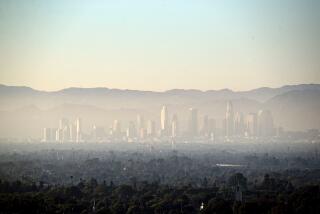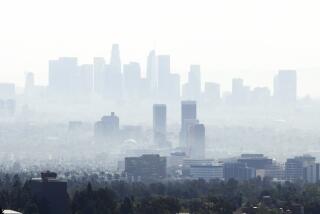Hole in Ozone May Stay Longer Than Expected
- Share via
SAN FRANCISCO — The ozone hole over Antarctica may persist two decades longer than predicted, until 2065, because ozone-destroying chemicals are still being released by developed nations a decade after their production and importation was banned.
The Montreal Protocol, ratified in 1987, banned the creation of chemicals such as chlorofluorocarbons, or CFCs, used as coolant by developed nations. It followed the discovery that such chemicals ripped apart ozone molecules and severely thinned the layer of ozone that sits about 20 miles above the Earth’s surface and shields the planet from ultraviolet radiation that causes cancer and cataracts and can harm wildlife.
Developing countries have been allowed to continue using the chemicals for several decades to avoid the higher cost of replacement chemicals. Scientists had predicted that the phasing out of the chemicals by developed nations would allow the ozone hole over Antarctica to recover by 2040 or 2050.
But measurements taken in 2003 and released Tuesday showed that emissions of the chemicals from the United States and Canada made up about 15% of the world total even though the nations are no longer allowed to produce the compounds, said Dale Hurst, an atmospheric chemist from the National Oceanic and Atmospheric Administration who made the measurements.
He estimated that developed countries accounted for about half of the world’s total.
“These fractions are surprisingly high,” Hurst said at a briefing on the issue held in San Francisco at the American Geophysical Union’s meeting of 11,000 earth scientists. “We would have expected them to be exhausted by 2003.”
Hurst said he believed the compounds were not new ones, but left over from old fire extinguishers, refrigerators and air-conditioning systems that were created before the ban went into effect but are being legally recycled and slowly leaking chemicals into the atmosphere.
Hurst said in an interview that he doubted there was much illicit production of two key CFCs in the U.S. or Canada because his measurements showed no traces of a chemical used in their production.
The overall rates of two major ozone-destroying chemicals, chlorine and bromine, peaked in 2002 and were now in decline, he said.
But scientists greatly underestimated the amount of already-produced chemicals that remained and were still in use, Hurst said.
The ozone hole over the Antarctic is now not expected to recover until 2065, said John Austin, a National Oceanic and Atmospheric Administration scientist who runs computer models of how the ozone layer will respond in the future.
The ozone hole over Antarctica was detected 20 years ago. This year’s hole was one of the largest recorded: 9.4 million square miles, about the size of North America. In 1998, the hole was 10.1 million square miles, according to NASA, and was similarly large in 2000 and 2003. Before 1985, the ozone hole measured less than 4 million square miles.
Hurst’s measurements taken by low-flying aircraft of ozone-destroying chemicals near the planet’s surface have been confirmed by satellite, said Michelle Santee, an atmospheric scientist at the Jet Propulsion Laboratory.
Total levels of chlorine in the stratosphere have declined in recent years, but they are still five times as high as natural levels, she said. In addition, the particular chorine molecule that destroys ozone -- chlorine oxide -- is still forming in high amounts during winter months over the Antarctic.
“As a result, the ozone has been eaten away,” Santee said.
Some of the chemicals involved persist for 100 years and can continually tear apart ozone through chemical reactions, she said.
The latest measurements will be used to create a scientific assessment of ozone depletion that will be given in 2007 to the signers of the Montreal Protocol and could be used to make changes in the treaty, said John Newman, a physicist and ozone expert at the NASA Goddard Space Flight Center in Greenbelt, Md.
“There will be a new look at these chemicals,” Newman said. But he added that because the compounds were already regulated, “I’m not sure there’s a lot we can do.”
CFCs are allowed to be recycled. Moving them from one place to another allows some of the chemicals to leak out. But the alternative to recycling would be to vent them to the atmosphere all at once, which would raise levels more suddenly, the scientists said.
Another compound, called methyl bromide, is used as a fumigant in agriculture and importation and is exempt from the Montreal Protocol because no sufficient replacement has been found, Hurst said. That compound is 45 to 60 times more effective at depleting ozone than CFCs are. But it persists for only eight months in the atmosphere, so it may not prove to be as much of a long-term problem for ozone, Hurst said.
The trends are the same for thinning ozone at the North Pole, but the problem there is not as severe because the area doesn’t consistently experience the extremely cold conditions needed for the ozone-depleting forms of chlorine to be created. Winds around the North Pole are also stronger and tend to blow ozone back into areas that have been thinned.
Austin’s models show that the ozone layer over the Arctic should recover between 2030 and 2040, but he said his estimates were more uncertain there than for the Antarctic because of weather patterns and long-term atmospheric patterns that could alter ozone levels in unpredictable ways.
More to Read
Sign up for Essential California
The most important California stories and recommendations in your inbox every morning.
You may occasionally receive promotional content from the Los Angeles Times.













